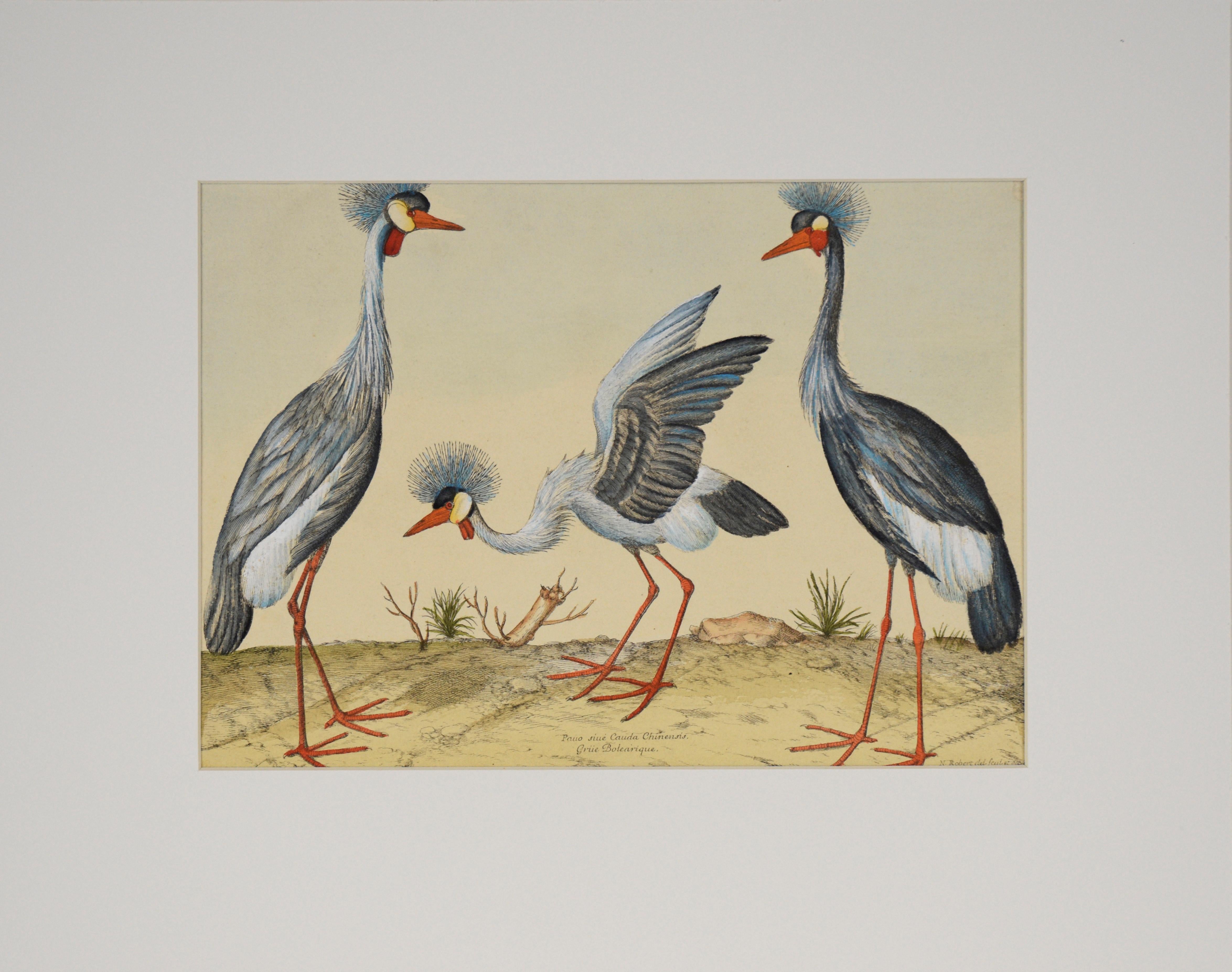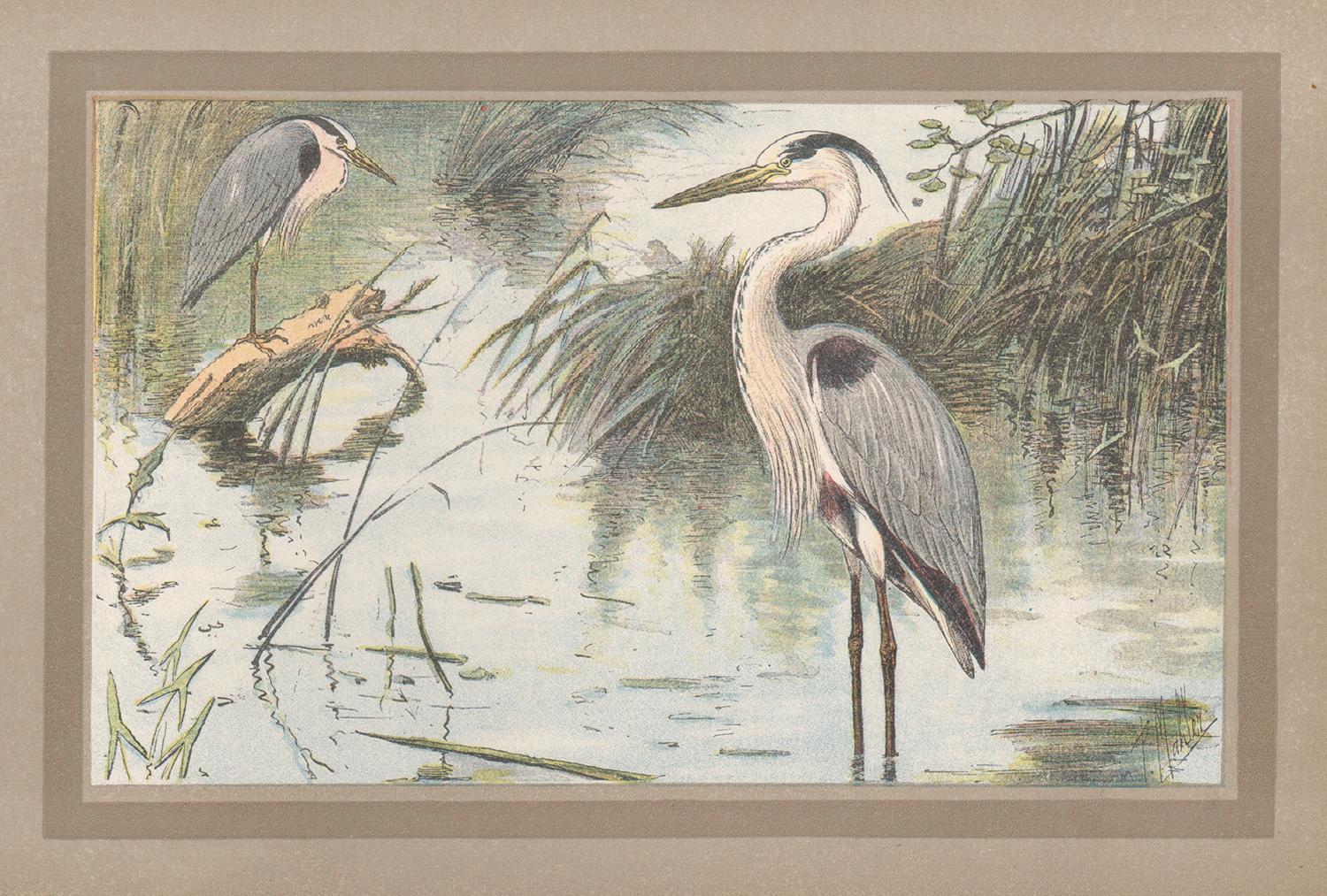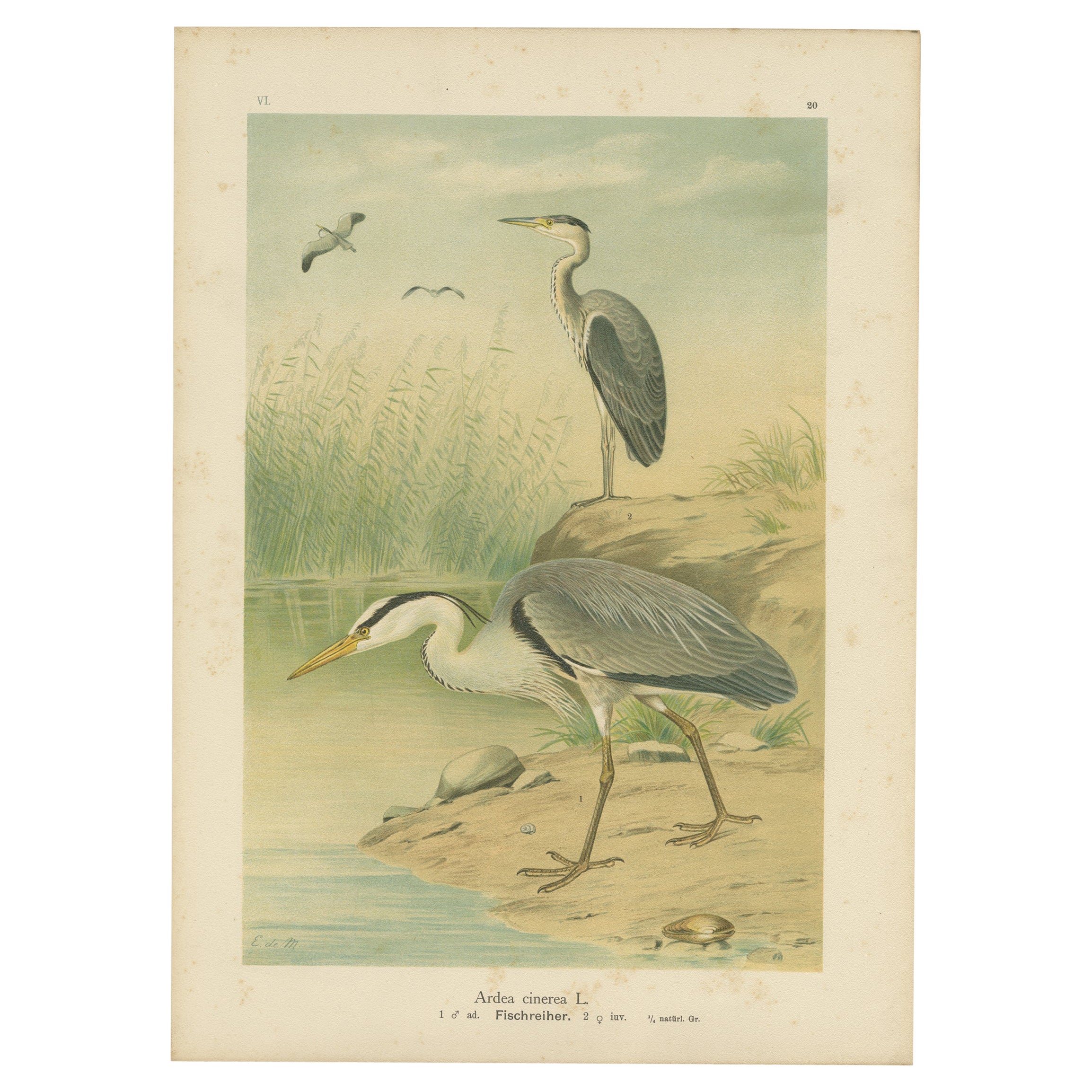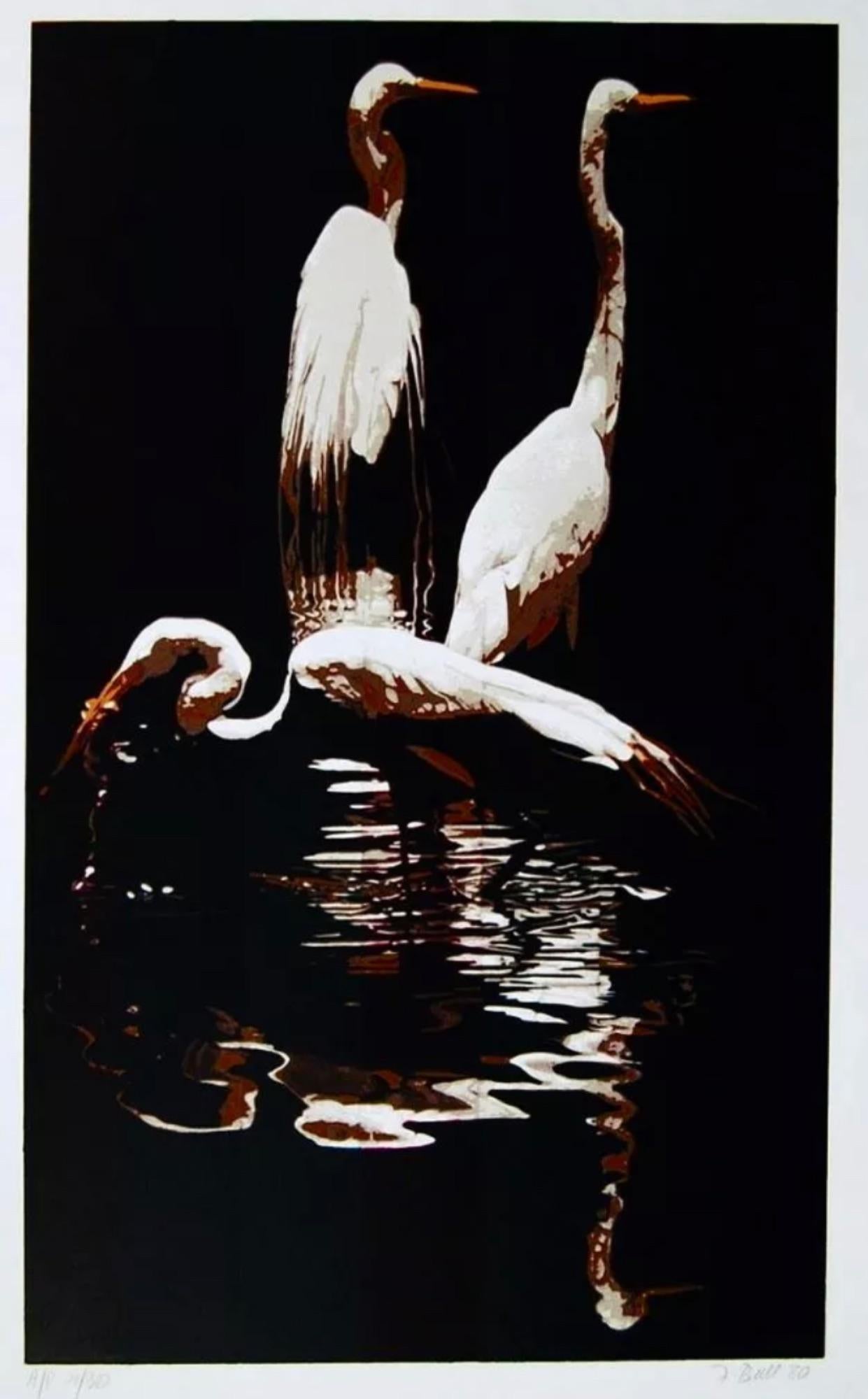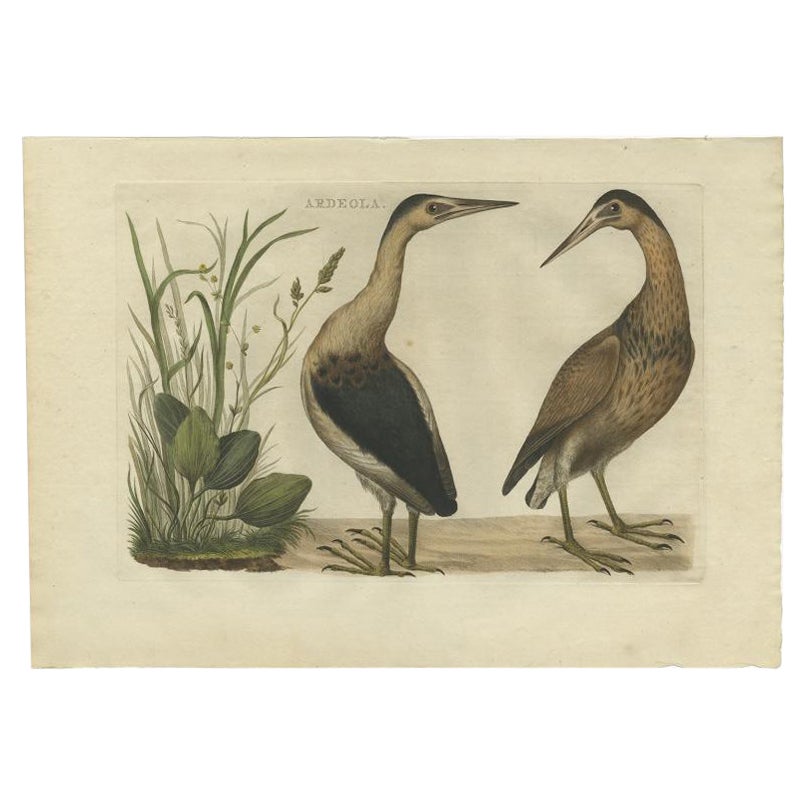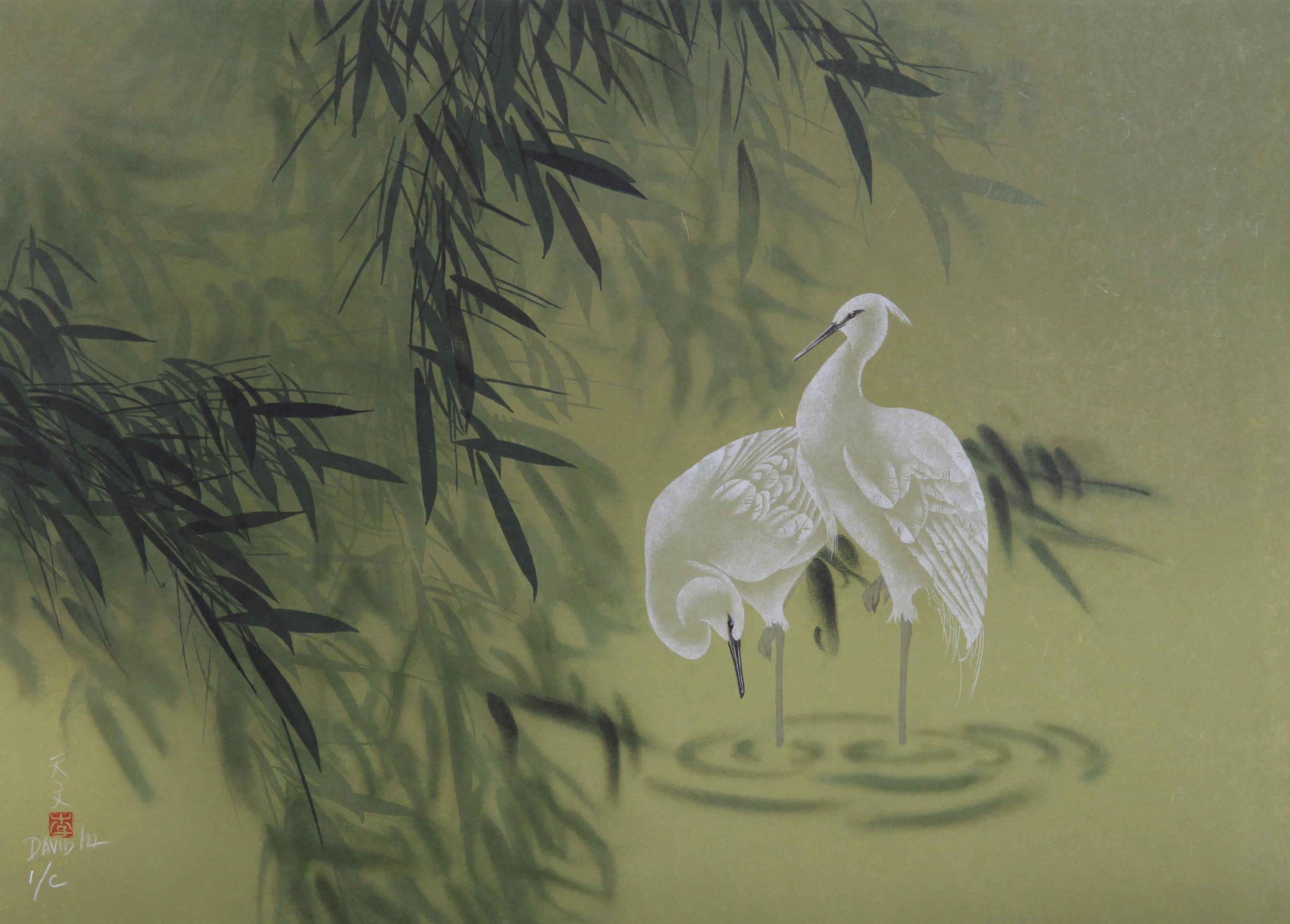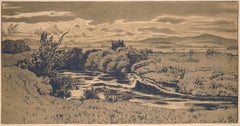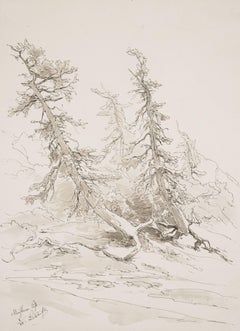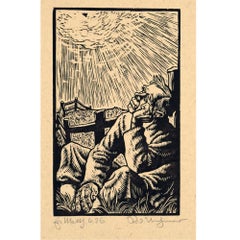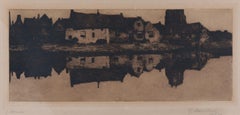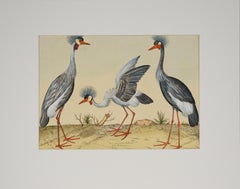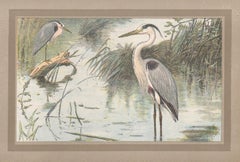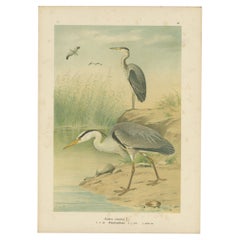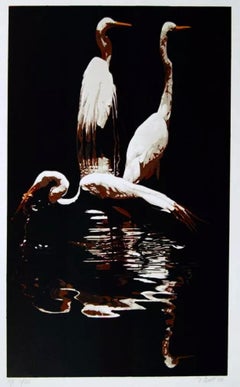Items Similar to Three Herons - At the flaming lake -
Want more images or videos?
Request additional images or videos from the seller
1 of 5
Rudolf HayderThree Herons - At the flaming lake -1st half of the 20th century
1st half of the 20th century
$532.28
£401.97
€450
CA$744.42
A$814.26
CHF 427.30
MX$9,738.07
NOK 5,392.54
SEK 5,030.58
DKK 3,427.89
About the Item
Rudolf Hayder (active in the 1st half of the 20th century), Heron. Color woodcut on thin Japanese paper, 24 x 29 cm (image), 29 x 36 cm (sheet size), signed by hand at lower right "R. Hayder" and titled by hand as "Reiher". Lower left inscribed by hand "Orig.[inal] woodcut, hand print".
- A little bit stained in the margins and very occasionally in the image, minimal hole above the signature, traces of creasing. At the back side's margins with remnants of an old mounting.
About the artwork
In the context of French Japonism, the color woodblock print, which was widespread in the Asian region, was rediscovered for Western art. The artists of the time, such as Édouard Manet, Claude Monet, Edgar Degas, Paul Gauguin and Vincent van Gogh, were inspired not only by the cultural influence, but also by the two-dimensionality of the pictorial spaces. Thus, color woodcuts became an important moment in the development of the modern pictorial concept founded by Impressionism.
In Rudolf Hayder's "Herons", too, the two-dimensionality of the pictorial space is decisive for the pictorial effect. The herons, surrounded by reeds, are framed by the yellow background of the lake, followed by the dark blue-greenish stripe of the opposite shore and, above it, the sky in a lighter blue-green. Formally, it is a sequence of planes, but the two-dimensionality of the motif creates a spatial effect. This spatiality in the surface creates an intense pictorial effect. Hayder intensifies this effect with the blazing lake. In terms of color, the water becomes a sunset. The yellow turns reddish brown toward the shore, then fades to brownish red, while the shore is a watery turquoise. There is something ephemeral about this color mood, as evidenced by the masterful water reflections on the reeds and the legs of the herons.
In Japan, the heron is considered very important. It is said to be able to live over 1000 years. Therefore, it is considered a symbol of longevity. It is also said to choose only one partner in life, which makes it a symbol of fidelity.
Without directly addressing these meanings, Hayder develops a relationship between the herons. On the left, two of the birds stand with their necks stretched, while the animal opposite has its head tucked in. This creates a dialogicity that the viewer cannot decipher, which in turn is fueled by the flaming water.
GERMAN VERSION
Rudolf Hayder (tätig in der 1. Hälfte 20. Jh.), Reiher. Farbholzschnitt auf dünnem Japanpapier, 24 x 29 cm (Darstellung), 29 x 36 cm (Blattmaß), rechts unten mit „R. Hayder“ handsigniert und als „Reiher“ handbetitelt. Links unten handvermerkt „Orig.[inal] Holzschnitt, Handabdruck“.
- In den Randbereichen etwas und sehr vereinzelt in der Darstellung stockfleckig, minimales Loch über der Signatur, Knickspuren. Rückseitig an den Rändern mit Falzresten einer alten Montage.
zum Kunstwerk
Im Rahmen des französischen Japonismus wurde der im asiatischen Raum verbreitete Farbholzschnitt für die westliche Kunst wiederentdeckt. Die damaligen Künstler, wie Édouard Manet, Claude Monet, Edgar Degas, Paul Gauguin und Vincent van Gogh, inspirierte neben der kulturellen Prägung, vor allem die Flächigkeit der Bildräume. Damit wurden die Farbholzschnitte zum wichtigen Moment bei der Ausprägung der vom Impressionismus begründeten modernen Bildauffassung.
Und auch bei den „Reihern“ von Rudolf Hayder ist die flächenmäßige Entwicklung des Bildraums für die Bildwirkung entscheidend. Die vom Schilf umgebenden Reiher werden vom gelben Fond des Sees hinterfangen, an den sich der dunkle blaugrünliche Streifen des anderen Ufers und darüber der in hellerem Blaugrün gehaltenen Himmel anschließen. Formal gesehen handelt es sich um eine Abfolge von Flächen, die durch die motivische Rückbindung allerdings eine Raumwirkung in der Flächigkeit entfalten. Diese Räumlichkeit in der Fläche erzeugt eine intensive Bildwirkung. Hayder steigert diese Wirkung durch den aufflammenden See. Farblich wird das Wasser zu einem Sonnenuntergang. Das Gelb färbt sich zum Ufer hin rotbraun, um dann in einem Braunrot auszuklingen, während das Ufer ein wasserartiges Türkis aufweist. Dass diese Farbstimmung etwas Ephemeres hat, wird von den meisterhaft ausgeführten Wasserreflexionen des Schilfs und der Beine der Reiher veranschaulicht.
In Japan wird dem Reiher eine wichtige Bedeutung beigemessen. Ihm wurde nachgesagt, über 1000 Jahre alt werden zu können. Daher gilt er als Symbol der Langlebigkeit. Zudem heißt es, er würde im Leben nur einen Partner wählen, weshalb er auch für die Treue einsteht.
Ohne diese Bedeutungen direkt aufzugreifen, entwickelt Hayder eine Beziehung der Reiher untereinander. Links stehen zwei der Vögel mit gerecktem Hals, während das Tier ihnen gegenüber seinen Kopf eingezogen hat. Es entsteht eine für den Betrachter nicht zu entschlüsseln Dialogizität, die wiederum vom flammenden Wasser befeuert wird.
- Creator:Rudolf Hayder (German)
- Creation Year:1st half of the 20th century
- Dimensions:Height: 9.45 in (24 cm)Width: 11.42 in (29 cm)
- Movement & Style:
- Period:
- Condition:
- Gallery Location:Berlin, DE
- Reference Number:1stDibs: LU2438212310042

About the Seller
5.0
Vetted Professional Seller
Every seller passes strict standards for authenticity and reliability
Established in 2014
1stDibs seller since 2023
22 sales on 1stDibs
- ShippingRetrieving quote...Shipping from: Berlin, Germany
- Return Policy
More From This Seller
View AllAt the pond / - The longing of the landscape -
Located in Berlin, DE
Hans Thoma (1839 Bernau - 1924 Karlsruhe), At the pond, 1897. Algraph on strong wove paper, published by Breitkopf und Härtel in Leipzig as ‘Zeitgenössisches Kunstblatt Nr. 148’, 23....
Category
1890s Realist Figurative Prints
Materials
Paper
$179 Sale Price
20% Off
Woodland / - The Inner Drama of the Landscape -
Located in Berlin, DE
Eduard Peithner von Lichtenfels (1833 Vienna - 1913 Berlin), Woodland, 1884. Watercolor and pen and ink on drawing paper, 30.4 cm x 22.5 cm, signed, dated and inscribed by the artist...
Category
1880s Landscape Drawings and Watercolors
Materials
Paper
$548 Sale Price
20% Off
The birds under the sky / - The Sunbird -
Located in Berlin, DE
Rudolf Nehmer (1912 Bobersberg - 1983 Dresden), The birds under the sky, 1948. Woodcut on yellowish wove paper, 11 cm x 18 cm (depiction), 43 cm x 30 cm (sheet size), signed “Rud.[ol...
Category
1940s Realist Figurative Prints
Materials
Woodcut
$170 Sale Price
20% Off
Evening - The depth of the visible -
Located in Berlin, DE
Max Clarenbach (1880 Neuss - Cologne 1952), Evening. Etching, 18 x 41 cm (platemark), 33.5 x 57 cm (frame), inscribed "Abend" in pencil at lower left, signed and dated "M. Clarenbach. 28.III.[19]09". Framed and mounted under glass.
- Somewhat browned and slightly foxed.
About the artwork
The horizontally elongated etching depicts the panoramic view of a small town as seen from the other side of the river. There are gabled houses on the left and a mighty church spire on the right. The bourgeois houses and the large religious building indicate the urban character. These buildings are rendered in dark tones to emphasise the lighter row of houses in the centre of the picture, closer to the water. The chiaroscuro contrast creates two parallel planes that open up a space for the imagination of what the city could be. The imagination is stimulated by the almost entirely dark, barely recognisable buildings, while the arm of the river leading into the city further stimulates the imagination.
However, as the silhouette of the city as a whole is reflected in the water, the parallel planes are perceived as a band of houses that stretches across the entire horizontality of the etching and seems to continue beyond the borders of the picture. The reflection has almost the same intensity as the houses themselves, so that the band of buildings merges with their reflection to form the dominant formal unit of the picture. Only the parallel horizontal hatching creates the convincing impression of seeing water, demonstrating Max Clarenbach's mastery of the etching needle.
The water is completely motionless, the reflection unclouded by the slightest movement of the waves, creating a symmetry within the formal unity of the cityscape and its reflection that goes beyond the motif of a mere cityscape. A pictorial order is established that integrates everything in the picture and has a metaphysical character as a structure of order that transcends the individual things. This pictorial order is not only relevant in the pictorial world, but the picture itself reveals the order of the reality it depicts. Revealing the metaphysical order of reality in the structures of its visibility is what drives Clarenbach as an artist and motivates him to return to the same circle of motifs.
The symmetry described is at the same time inherent an asymmetry that is a reflection on art: While the real cityscape is cut off at the top of the picture, two chimneys and above all the church tower are not visible, the reflection illustrates reality in its entirety. The reflection occupies a much larger space in the picture than reality itself. Since antiquity, art has been understood primarily as a reflection of reality, but here Clarenbach makes it clear that art is not a mere appearance, which can at best be a reflection of reality, but that art has the potential to reveal reality itself.
The revealed structure of order is by no means purely formalistic; it appears at the same time as the mood of the landscape. The picture is filled with an almost sacred silence. Nothing in the picture evokes a sound, and there is complete stillness. There are no people in Clarenbach's landscape paintings to bring action into the picture. Not even we ourselves are assigned a viewing position in the picture, so that we do not become thematic subjects of action. Clarenbach also refrains from depicting technical achievements. The absence of man and technology creates an atmosphere of timelessness. Even if the specific date proves that Clarenbach is depicting something that happened before his eyes, without the date we would not be able to say which decade, or even which century, we are in. The motionless stillness, then, does not result in time being frozen in the picture, but rather in a timeless eternity that is nevertheless, as the title "Abend" (evening), added by Clarenbach himself, makes clear, a phenomenon of transition. The landscape of the stalls is about to be completely plunged into darkness, the buildings behind it only faintly discernible. The slightly darkened state of the sheet is in keeping with this transitional quality, which also lends the scene a sepia quality that underlines its timelessness. And yet the depiction is tied to a very specific time. Clarenbach dates the picture to the evening of 28 March 1909, which does not refer to the making of the etching, but to the capture of the landscape's essence in the landscape itself.
If the real landscape is thus in a state of transition, and therefore something ephemeral, art reveals its true nature in that reality, subject to the flow of phenomena, is transferred to an eternal moment, subject to a supra-temporal structure of order - revealed by art. Despite this supratemporality, the picture also shows the harbingers of night as the coming darkening of the world, which gives the picture a deeply melancholy quality, enhanced by the browning of the leaf.
It is the philosophical content and the lyrical-melancholic effect of the graphic that give it its enchanting power. Once we are immersed in the image, it literally takes a jerk to disengage from it.
This etching, so characteristic of Max Clarenbach's art, is - not least because of its dimensions - a major work in his graphic oeuvre.
About the artist
Born into poverty and orphaned at an early age, the artistically gifted young Max Clarenbach was discovered by Andreas Achenbach and admitted to the Düsseldorf Art Academy at the age of 13.
"Completely penniless, I worked for an uncle in a cardboard factory in the evenings to pay for my studies.”
- Max Clarenbach
At the academy he studied under Arthur Kampf, among others, and in 1897 was accepted into Eugen Dücker...
Category
Early 1900s Realist Landscape Prints
Materials
Etching
$548 Sale Price
20% Off
Lonely and lively lake / - Calm and Movement -
Located in Berlin, DE
Reinhard Stangl (*1959 Leipzig), Lonely and lively lake, 1985. White heightened blue colored pencil drawings on brown paper, each 21 cm x 29 cm, signed lower right and once dated 198...
Category
1980s Realist Figurative Drawings and Watercolors
Materials
Paper
$738 Sale Price
20% Off
Late Summer River Landscape / - Realistic Impression -
By Jan Hillebrand Wijsmüller
Located in Berlin, DE
Jan Hillebrand Wijsmuller (1855 Amsterdam - 1925 ibid.), Late Summer River Landscape, oil on canvas, relined, 34 x 56 cm (inside measurement), 43 x 64 cm (frame), signed J[an] H[illebrand] Wijsmuller at lower right.
- in good condition, the frame with isolated bumped spots
- Realistic Impression -
About the artwork
The panoramic landscape format shows a river landscape, with the course of the river, which curves to the right, leading the eye into the depths of the picture and tempting it to continue the landscape in the imagination beyond the visible area. At the same time, however, the fact that the landscape is not visible through the bend in the river focuses our gaze on the entirety of the landscape depicted, without prompting us to focus on distant details. Accordingly, the brushstroke is not designed to render details with realistic precision. In the front left area of the river there is even a completely free brushwork, trained by Impressionism, which nevertheless remains committed to representational and convincingly suggests the movement of the water.
Regardless of the distance of the observer, the entire picture is painted with the same broad brushstroke, so that the landscape is given as an impression. And yet this impression is not ephemeral, as in the case of French Impressionism, to put it exaggeratedly, but reveals to us the essence of the landscape in all its richness. This is why the Dutch variant of Impressionism is always also a realism, although the pictures appear less progressive, but still contain a dimension of landscape painting that is lost with progress.
In the impression, the reality of the landscape is revealed, and this happens as we experience the landscape in the visual impression. Wijsmuller does not depict houses or people in order to allow the experience of the landscape to fully unfold. The experience is determined first and foremost by the river, which does not flow into the picture from our point of view, but towards us. Where the river begins to bend, the water is churned by a rapids. Toward us, the riverbed widens and the water comes to rest, covering the entire width of the foreground like a mirror.
The stillness of the water corresponds to the evening mood of the late summer landscape, in which the warm tones of the evening light blend with the yellow and brown tones of the plants. A gentle, almost idyllic reality, carried by the brushstroke, yet animated by a liveliness that is also made visible by the brushstroke. The broad, dynamically placed brushstrokes evoke the movement of the treetops and animate even the immobile reeds, while the trunks on the right bank, executed in virtuoso white strokes that seem like markings, make the sunlight shine. On the other bank, a carpet of light also spreads out, its energetic effect again expressed in the brushstroke. The dynamic of the landscape is further enhanced by the complementary color contrasts between the greens, yellows, and browns on the one hand and the blue of the all-encompassing sky on the other. A contrast that is intensified by the reflection in the water.
The evening coming to rest of the landscape is thus at the same time an all-encompassing contrasting and yet in itself harmonious movement. This reality becomes accessible to us as an experience in the impression of the landscape.
About the artist
Jan Hillebrand Wijsmuller entered the Royal Academy of Arts in Amsterdam in 1876 and studied under the innovative Professor August Allebé, who was famous for the Amsterdam Impressionism, also known as the Allebé School.
In 1877, Wijsmuller transferred to the Hague Academy of Art, and thus to the Hague School, and then completed his studies at the Brussels Academy of Art. Returning to the Netherlands, Wijsmuller opened his own studio in Amsterdam.
In 1883 he won the prestigious Young Artist Award, donated by Willink van Collen, which made Wijsmuller a well-known and sought-after artist.
Wijsmuller was a member of the Societät Arti et Amicitiae Amsterdam and the Pulchri Studio in The Hague.
Wijsmuller belongs to the second generation of the Hague School. While Vincent van Gogh described the protagonists of the first generation to his brother Theo as "the great gray people," the second generation, and Wijsmuller in particular, used a much more colorful palette. His oeuvre makes him a major player in Dutch Impressionism...
Category
1890s Impressionist Landscape Paintings
Materials
Canvas
$3,595 Sale Price
20% Off
You May Also Like
"Three Herons" - Hand Watercolor Engraving
Located in Soquel, CA
"Three Herons" - Hand Watercolor Engraving
"Three Herons" from a collection of the Most Rare Birds Drawn and Engraved From Life, A Natural and Rational History of the Different Bird...
Category
17th Century French School Figurative Drawings and Watercolors
Materials
Paper, Watercolor, Engraving
$772 Sale Price
20% Off
Grey Heron, French antique natural history water bird art illustration print
Located in Melbourne, Victoria
French chromolithograph, published in 1931. Printed title lower right of sheet. Plate number top right. From a French series of illustrations of birds.
195mm by 265mm (sheet)
Category
1930s Art Deco Animal Prints
Materials
Lithograph
Antique Bird Print of the Grey Heron by Naumann, circa 1895
Located in Langweer, NL
Grey Heron by E. de Maes, Antique Bird Lithograph Ardea cinerea c.1895
This elegant antique ornithological print depicts the *Ardea cinerea*,...
Category
Antique Late 19th Century Prints
Materials
Paper
Three Egrets, Fran Bull
By Fran Bull
Located in Fairfield, CT
Artist: Fran Bull (1938)
Title: Three Egrets
Year: 1980
Edition: A.P./17/30; 250, plus proofs.
Medium: Silkscreen on Rives BFK White Paper
Size: 22 x 30 inches
Condition: Good
Inscri...
Category
1980s Pop Art Landscape Prints
Materials
Screen
$1,276 Sale Price
20% Off
Antique Bird Print of Herons by Sepp & Nozeman, 1770
Located in Langweer, NL
Antique print titled 'Ardeola'. This print depicts two herons. The Herons are the long-legged freshwater and coastal birds in the family Ardeidae, with 6...
Category
Antique 18th Century Prints
Materials
Paper
$804 Sale Price
20% Off
White Herons, Impressionist Lithograph by David Lee
Located in Long Island City, NY
David Lee, Chinese (1944 - ) - White Herons, Year: circa 1985, Medium: Lithograph, signed and numbered in pencil, Edition: 100, Size: 21 x 29 in. (53.34 x 73.66 cm), Descriptio...
Category
1980s Impressionist Animal Prints
Materials
Lithograph
